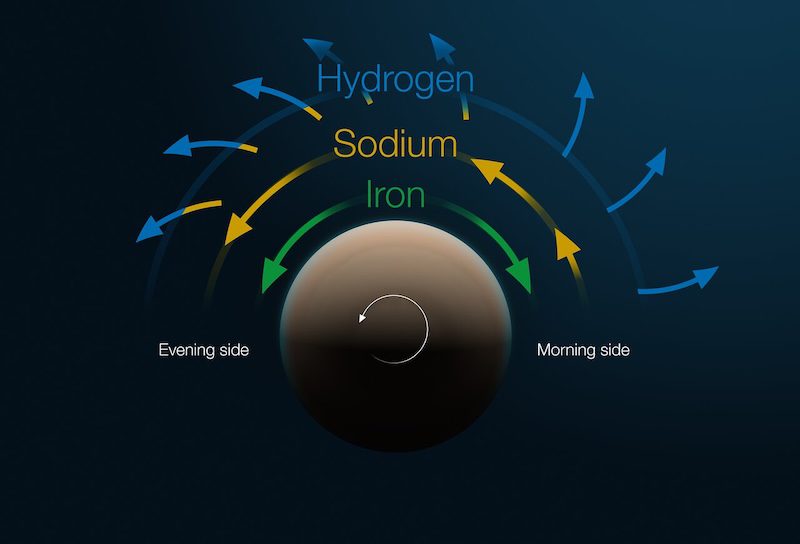Here it is! Our 1st 3D weather map for an exoplanet 900 light-years away. Video via European Southern Observatory (ESO).
- Astronomers have created the first 3D weather map for an exoplanet, located some 900 light-years away.
- The planet is called WASP-121b, aka Tylos. It’s a hot Jupiter in the direction of the constellation Puppis. It orbits close to its star, with the same side always facing the star.
- The atmosphere has three distinct layers, with powerful winds. It contains elements such iron and titanium.
For the first time ever, astronomers have created a 3D map that lets them scrutinize the weather on an alien exoplanet. Researchers at the European Southern Observatory (ESO) in Germany said on February 18, 2025, that they used all four telescopes of the Very Large Telescope (VLT) array in Chile to create this map. The exoplanet – called WASP-121b, aka Tylos – is a hot Jupiter found 900 light-years away in the direction of the constellation Puppis. The map revealed powerful winds on this planet, and complex weather patterns, in three distinct layers of atmosphere.
It also revealed unusual elements in the planet’s atmosphere, such as iron and titanium.
The international research team published their peer-reviewed findings in the journal Nature on February 18. A free preprint version is also available on arXiv. In addition, a companion peer-reviewed study was also published in Astronomy & Astrophysics on February 19.
3D weather map ‘feels like science fiction’
The researchers found that the atmosphere of WASP-121b has three layers. Roughly speaking, it has iron winds in its bottom layer of atmosphere, followed by a fast jet stream of sodium in the middle, and then an upper layer of hydrogen winds.
Julia Victoria Seidel at ESO is the lead author of the new study. She said:
This planet’s atmosphere behaves in ways that challenge our understanding of how weather works, not just on Earth, but on all planets. It feels like something out of science fiction.
What we found was surprising: a jet stream rotates material around the planet’s equator, while a separate flow at lower levels of the atmosphere moves gas from the hot side to the cooler side.
This kind of climate has never been seen before on any planet. Even the strongest hurricanes in the solar system seem calm in comparison.
Co-author Leonardo A. dos Santos at the Space Telescope Science Institute (STScI) in Baltimore, Maryland, added:
The Very Large Telescope enabled us to probe three different layers of the exoplanet’s atmosphere in one fell swoop. It’s the kind of observation that is very challenging to do with space telescopes …
Previously, other observations had not seen the titanium, but these new observations showed that titanium is deep in the atmosphere of WASP-121b .
Here’s how they did it
The researchers used the telescopes to peer through the planet’s atmosphere. WASP-121b is a hot Jupiter, which means it’s a giant gas planet that orbits close to its star. So its atmosphere is thick. Plus it’s so close to its star that a full year on this planet – one full orbit around its sun – is only 30 hours long. In addition, the planet is also tidally locked, meaning that one side always faces its star. It’s similar one side of our moon always facing Earth. As a result, that side of the planet is scorching hot, while the other side remains shaded and cooler.
The ESPRESSO instrument on the Very Large Telescope combined the light of the four large telescope units into a single signal. The technique allowed astronomers to see finer details in the planet’s atmosphere than would otherwise be possible. In fact, ESPRESSO was able to do this using only one transit (crossing) of the planet in front of its star. In most cases, they said, multiple transits are required to achieve a result.

Truly out of science fiction! ?Using ESO’s #VLT, astronomers have mapped the 3D structure of an exoplanet’s atmosphere for the first time.This atmosphere behaves in ways that challenge our understanding of how weather works.? ? #exoplanets https://www.eso.org/public/news/eso2504/
Uncovering incredible things
Studying an exoplanet’s atmosphere in such detail is an incredible achievement. And, these scientists say, it’s only the beginning. As co-author Bibiana Prinoth at ESO and Lund University in Sweden commented:
It’s truly mind-blowing that we’re able to study details like the chemical makeup and weather patterns of a planet at such a vast distance. The ELT [Extremely Large Telescope] will be a game-changer for studying exoplanet atmospheres. This experience makes me feel like we’re on the verge of uncovering incredible things we can only dream about now.
Bottom line: Astronomers have created the 1st 3D weather map for an exoplanet 900 light-years away. This hot Jupiter has powerful winds and three distinct atmospheric layers.
Sources:
Vertical structure of an exoplanet’s atmospheric jet stream
Vertical structure of an exoplanet’s atmospheric jet stream (preprint)
Titanium chemistry of WASP-121 b with ESPRESSO in 4-UT mode
Via European Southern Observatory
Read more: Webb telescope 1st close look at exoplanet atmosphere
Read more: Exoplanet TRAPPIST-1 b might have a hazy atmosphere
Source link
Read More
thesportsocean
Read our previous article: Where will the ‘Blood Moon’ total lunar eclipse be visible in March 2025?
